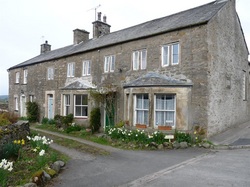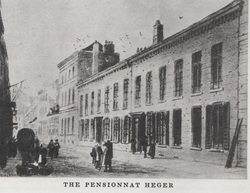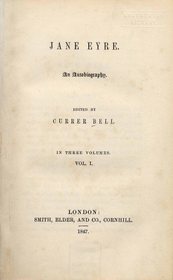Charlotte Brontë was born on 21st of April 1816 at Thornton, Bradford, Yorkshire, the third child of Patrick and Maria Brontë. She was the oldest of the children that survived until adulthood. In 1824 Charlotte attended the Clergy's Daughter's School with her elder sisters Maria, Elizabeth, and her younger sister Emily. She was there until her elder sisters fell ill in the spring of 1825, when they were all taken home, and where Maria and Elizabeth soon after died of what was probably tuberculosis. This would be Charlotte's basis for the Lowood School in 'Jane Eyre'. Charlotte and her three other siblings were educated at home by their father and aunt, and they spent most of their free time together writing their amazing juvenilia, Charlotte's comprising mostly of the Tales of Angria.
Charlotte attended Miss Wooler's school at Roe Head in 1831 through 1832 and she then returned here to teach from 1835 to 1838. She then worked as a governess for 3 years , first in and later in Rawdon. This was a position that she absolutely abhorred, but she worked in order to support her family and her brother's schooling. In 1942 Charlotte and Emily traveled to Brussels, Belgium to study at the Penisonnat Heger in order to refine their accomplishments so that they could open a school of their own. This is where Charlotte gets her inspiration for her novel 'Villette', which is based on Brussels, and is more autobiographical than any of her other works. While at the Pensionnat, Charlotte starts to fall in love with the headmistress's husband, Constatine Heger, who taught her French. After a brief visit home to attend her aunt's funeral, Charlotte returns to Brussels at the start of 1843, without Emily, to attend the school for another year.
In January 1844 Charlotte returns to Haworth, where her and her sisters discuss, but can never realize, their ambition to open a school for girls. Charlotte enlightens upon a book of Emily's poems, and after much persuasion, gets Emily to agree to publish her poems along with Charlotte's and Anne's. The book was published under their pens names Currer, Ellis, and Acton Bell, respectively. The book only sold two copies but this only encouraged Charlotte. Her first novel 'The Professor' was rejected, while her sister's novels, 'Wuthering Heights' and 'Agnes Grey', were accepted for publication. Charlotte immediately set upon working on a new novel, 'Jane Eyre'. She then submitted it to Smith, Elder, and Co. who published it in October of 1847, two months before her sister's novels, whose publishers where causing many delays in the process. Charlotte's novel was an immediate success with the public, although it received harsh reviews from some critics. In 1848, after rumors that the Bell brothers where actually one person, she and Anne traveled to London to prove otherwise to Charlotte's publisher, George Smith.
In the space of time from that September to May of 1849, Charlotte lost all of her siblings to tuberculosis. In the midst of all this Charlotte was writing 'Shirley" which was published in 1849. During the next few years Charlotte suffers much from loneliness and therefore wrote very little. She experienced some 'long, stormy days and nights...when I felt such a craving for support and companionship as I cannot express'. In 1850 she met and became good friends with Elizabeth Gaskell who would be her future biographer. Finally in 1853 Charlotte publishes her third novel 'Villette' , after working on it for a year. During this time she gets to know Arthur Bell Nicolls, by correspondence, after he proposed and then left Haworth as a result of her denial (probably influenced by her father, who thought Nicholls was not good enough for her). Through this correspondence she grows to like and respect Nicholls and after much persuasion on her part, she convinces her father to agree to the union and the two were married in June of 1854.
Although she was not 'in love' with Nicholls in the beginning, contrary to some, she does grow to love him and to put it into her own words, 'I have a good, kind, attached husband; and every day my own attachment to him grows stronger.' By the autumn of that year she was in as good of health and spirits than she has ever been in, and her friends also suspected that she may be pregnant, which she was. Alas this happiness was not to last. On November 28th 1854, she and her husband walked to the nearby waterfalls, now known as the Brontë falls. On the way home they got caught in a showering rain, and she caught a lingering cold, which made her thin and weak. Her letters, for the rest of that year and the beginning of the next, all suggest ill health and suffering. Soon after the New Year she was attacked by perpetual nausea and faintness and only ate, what she termed, 'what a wren would starve on'. She was now confined to her bed and from there she wrote her last two letters, probably in February, to Miss Nussey, her lifelong friend, and a Brussels school fellow. In her letter to Miss Nussey she states that 'I find in my husband the tenderest nurse, the kindest support, the best earthy comfort that ever woman had'. These were some of the last lines that she wrote. In her last hours she awakened on hearing her husband praying to God to spare her, and she whispered to him, 'Oh, I am not going to die, am I? He will not separate us, we have been so happy.' On Saturday morning, March 31st 1855, she met with her untimely death, the cause of which has been often debated. Her death certificate says the cause was 'phthisis' which was a wasting of the body, often attributed to tuberculosis. But now researchers believe that she died from complications from her pregnancy and the constant vomiting. In 1857 her husband agrees to the publication of Charlotte's first novel, 'The Professor' and her biography, written by her friend Elizabeth Gaskell, was also published.




